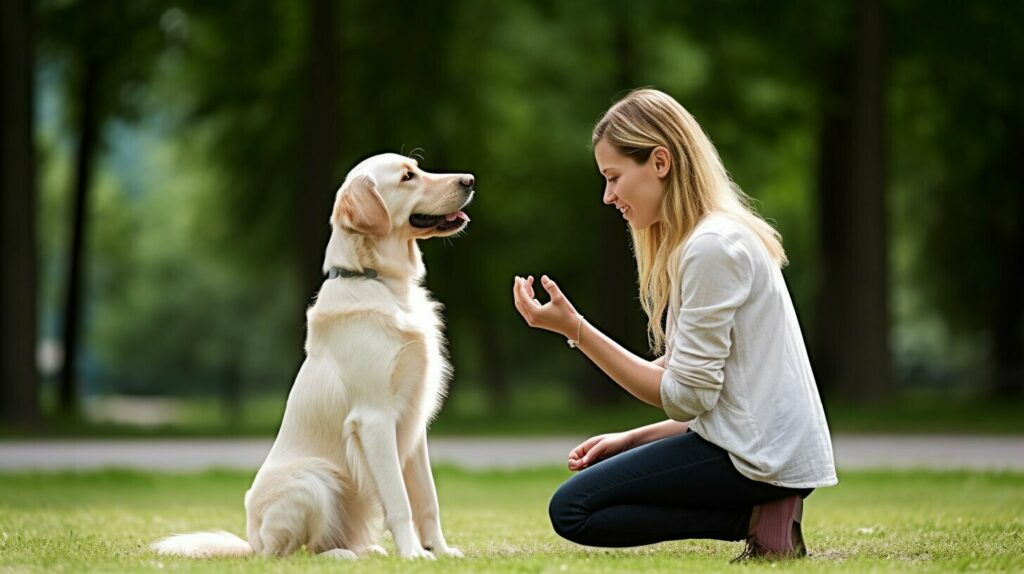Dogs are wonderful companions, but sometimes they can exhibit behavior problems that can be frustrating and even dangerous. Many dog owners face issues such as aggression, separation anxiety, leash pulling, and excessive barking, among others. Addressing these issues requires patience, knowledge, and persistence. This article provides valuable tips and expert guidance to help dog owners manage and resolve behavior problems and create a happy and fulfilling relationship with their furry friend.
Key Takeaways:
- Behavior problems in dogs are common and can be managed effectively
- Understanding a dog's instincts, breed characteristics, and past experiences is essential for addressing behavior issues
- Positive reinforcement methods, consistency, and patience are key elements in successful dog training
- Professional help may be necessary for severe or complex behavior problems
- Preventive measures such as early socialization and regular exercise can minimize the occurrence of behavior issues
Understanding Dog Behavior Problems
Dogs are unique animals with their own behaviors and instincts. Understanding the reasons behind the behavior problems in dogs is crucial for effective modification and training. Many canine behavior issues can be attributed to a combination of factors, including breed characteristics, past experiences, and natural instincts.
For example, a herding breed such as a Border Collie may exhibit chase behavior, while a guarding breed such as a German Shepherd may show territorial aggression. Similarly, a dog with a traumatic past may display fear-based aggression or anxiety. Recognizing and interpreting these behaviors is essential in effectively addressing behavior problems in dogs.
It's important to note that some dogs may exhibit undesirable behavior simply due to a lack of training or inadequate socialization. For instance, a dog that has not been properly socialized may develop separation anxiety or excessive barking. By understanding the underlying reasons behind behavior problems, dog owners can develop a more effective approach to training and behavior modification.

"A dog is the only thing on earth that loves you more than he loves himself." - Josh Billings
Effective Dog Training Techniques
When it comes to modifying a dog's behavior, positive reinforcement methods are generally considered to be the most effective. Positive reinforcement involves rewarding good behavior instead of punishing bad behavior, which encourages the dog to repeat the desired behavior. One popular form of positive reinforcement is clicker training, which uses a small, handheld clicker to signal when the dog has done something correctly. When the dog hears the click, they know that a treat or reward is coming.
Consistency is also key when it comes to dog training. It's important to establish clear rules and boundaries and stick to them. Dogs thrive on routine, so regular training sessions at the same time and in the same place can be very effective.
In addition to positive reinforcement, other training techniques may also be effective depending on the dog's personality and behavior issues. These include:
- Counterconditioning: This involves changing a dog's negative emotional response to a particular trigger by gradually associating the trigger with positive experiences.
- Desensitization: This involves gradually exposing the dog to the trigger that causes the unwanted behavior, starting with a low-intensity version of the trigger and gradually increasing the intensity over time.
- Marker training: This involves using a verbal or physical cue to mark good behavior, similar to clicker training but without the clicker.
It's important to note that every dog is different, and what works for one may not work for another. It's always a good idea to consult with a professional dog trainer or behaviorist for guidance on the most effective training techniques for your specific dog and behavior issues.

Addressing Puppy Behavior Problems
Puppies are adorable, but they can also be a handful at times. If your puppy is exhibiting signs of behavior problems, it's important to address them as soon as possible to prevent them from becoming ingrained habits. Here are some tips for managing and training your puppy:
Potty Training
One of the first behaviors to tackle with your puppy is potty training. Consistency is key in this training, as puppies need to go out frequently throughout the day. Establish a schedule for taking your puppy out, and reward them with praise and treats when they successfully go outside. Accidents will happen, but avoid punishment and instead redirect your puppy to the appropriate potty area.
Biting and Chewing
Puppies love to explore their world through their mouth, but this can lead to destructive chewing and painful biting. Provide plenty of appropriate chew toys and redirect your puppy's attention when they start nibbling on inappropriate items. When it comes to biting, make a yelping noise to startle your puppy and immediately redirect their attention to a chew toy.
Socialization
Proper socialization is crucial for a well-adjusted and friendly adult dog. Introduce your puppy to a variety of people, animals, and environments in a positive and controlled manner to prevent fear and aggression issues from developing.
Training Techniques
Positive reinforcement techniques, such as clicker training, have been shown to be effective with puppies. Consistency and patience are key when training your puppy, and it's important to set clear boundaries and rules from the start. Seek guidance from a professional trainer if you need additional help.
Remember, puppies are still learning and developing, so be patient and consistent in your training efforts. With time and effort, you can help your puppy become a well-behaved and happy companion.

Dealing with Dog Aggression
Aggression is a serious behavior problem that many dog owners face. It can be caused by various factors, such as fear, dominance, territoriality, or lack of socialization. It is important to understand the type of aggression your dog displays in order to address the issue effectively.
Fear-based aggression is often triggered by new situations or people, and can manifest as growling, barking, or biting. Dominance aggression, on the other hand, usually occurs when a dog feels threatened, and can be displayed by standing tall, raising the hackles, or staring.
If your dog displays aggressive behavior, it is important to seek professional help. A certified trainer or behaviorist can diagnose the type of aggression and develop a behavior modification plan to help manage and modify the behavior. In severe cases, medication may also be recommended.
During the behavior modification process, it is important to avoid situations that may trigger aggressive behavior and to provide a safe and calm environment for your dog. Consistent and positive training techniques, such as clicker training and positive reinforcement, can be effective in modifying the behavior in the long term.
"It is important to understand the type of aggression your dog displays in order to address the issue effectively."
Remember, aggression is a serious issue that should not be ignored or taken lightly. Seeking professional help and implementing consistent behavior modification techniques can lead to a happier and safer relationship between you and your dog.
Managing Separation Anxiety in Dogs
If you've ever come home to find your dog has chewed up the furniture or howled for hours on end, your furry friend may be suffering from separation anxiety. This condition is common in dogs and can cause significant distress for both the dog and the owner.
Signs and Symptoms: Separation anxiety may manifest in a variety of ways, including excessive barking or howling, destructive behavior, and self-injury. Some dogs may become excessively clingy, following their owners from room to room and refusing to be left alone.
Managing Separation Anxiety: While there's no magic solution to curing separation anxiety, there are many techniques that can help manage and reduce its impact. Gradual desensitization and counterconditioning are two of the most effective techniques. This involves gradually increasing the length of time the dog is left alone, while providing positive reinforcement for calm behavior. Providing plenty of exercise and mental stimulation can also help reduce anxiety and boredom.
Professional Help: In more severe cases of separation anxiety, it may be necessary to seek the help of a professional dog trainer or behaviorist. Medication may also be prescribed to help manage anxiety levels in some dogs.
Remember, with patience and consistency, most dogs can learn to cope with being left alone. By implementing the right techniques and seeking professional help when necessary, you can help your furry friend overcome separation anxiety and enjoy a happier, healthier life.

Curbing Leash Pulling Behavior
Does your dog pull on the leash during walks, making the experience stressful and unpleasant? Leash pulling is a common behavior problem in dogs that can be addressed with the right training techniques.
One of the most effective methods to curb leash pulling is loose leash walking. This involves teaching your dog to walk calmly beside you without pulling. Use positive reinforcement to reward your dog for walking on a loose leash and stop and wait if they start pulling.
| Training Tips: |
|
|---|
Leash training exercises, such as changing direction or stopping and starting, can also help decrease leash pulling. These techniques teach your dog to pay attention to your movements and stay focused on you during walks.
It's essential to remain patient and consistent in your training efforts. With time and practice, your dog will learn to walk calmly on a leash and enjoy walks with you. (Image source: https://seowriting.ai/32_6.png)
Managing Excessive Barking in Dogs
Excessive barking is a common problem among dogs and can be frustrating for dog owners. It is important to understand the potential reasons behind excessive barking, such as boredom, anxiety, or territorial behavior. Once you understand the underlying cause, you can work on addressing the behavior.
One effective technique for managing excessive barking is to teach your dog the "quiet" command. Start by rewarding your dog for barking on command, then introduce the "quiet" command and reward your dog for stopping the barking. Be consistent with the training and gradually increase the duration of quiet time before offering a reward.
Another strategy for managing excessive barking is to provide your dog with plenty of exercise and mental stimulation. Boredom is a common cause of excessive barking, so make sure your dog is getting enough physical and mental stimulation throughout the day.
Environmental modifications can also help in managing excessive barking. For example, if your dog excessively barks at people passing by your house, consider closing the curtains or moving your dog to a different area of the house. You can also use white noise machines or calming music to create a more soothing environment for your dog.
When dealing with excessive barking, it is important to avoid punishment-based techniques. These can lead to fear and anxiety in your dog, exacerbating the behavior problem. Instead, focus on positive reinforcement methods and be patient throughout the training process.
Remember, excessive barking can be a complex issue and may require professional help in severe cases. Don't hesitate to seek the guidance of a certified dog trainer or behaviorist if needed.

Understanding Resource Guarding Behavior
Resource guarding is a common behavior problem in dogs. It refers to when a dog becomes possessive of certain items or locations and reacts aggressively when someone tries to take them away or approach them. This behavior can be directed towards food, toys, beds, or even people.
Resource guarding can be caused by various factors, such as genetics, lack of early socialization, or past experiences. Dogs that have had to compete for resources in the past or were not taught to share during their early life stage are more prone to develop resource guarding behavior.
If you suspect that your dog is displaying resource guarding behavior, it is essential to manage the situation carefully. Punishing the dog for its behavior will only escalate the issue and is not recommended. Instead, the goal is to teach the dog to feel comfortable with giving up or sharing its resources.
One strategy is to trade items with the dog. For instance, if the dog is guarding a toy, offer a more valuable treat simultaneously and exchange the toy for the treat. Repeat this process regularly to make the dog feel comfortable with giving up the toy. Similarly, feeding the dog close to people, or dropping treats while someone approach the dog’s food bowl can help reduce aggressive behavior towards food.
Working with a professional trainer or behaviorist can be beneficial in managing resource guarding behavior. They can assess the severity of the issue and develop an individualized plan to address the problem. Remember, with patience and consistent effort, most cases of resource guarding can be successfully managed.

Seeking Professional Help for Behavior Problems
While many behavior problems can be addressed through training and management techniques, some require the assistance of a professional. Certified trainers, behaviorists, and veterinarians specialize in diagnosing and developing effective behavior modification plans for dogs with complex or severe behavior issues. Seek professional help if:
- Your dog exhibits aggressive behavior towards people or other animals
- Your dog displays destructive behavior, such as chewing on furniture or digging holes in the yard
- Your dog experiences severe anxiety or phobias, such as separation anxiety or fear of thunderstorms
- Your dog exhibits obsessive-compulsive behaviors, such as excessive licking or tail chasing
When choosing a professional, look for someone who is certified and has experience working with your specific behavior issue. Ask for referrals from friends or your veterinarian, and conduct research online to find a suitable professional. Be prepared to provide a detailed history of your dog's behavior, including any triggers or situational factors, to aid in the diagnosis and treatment plan.

Remember that with the right guidance and techniques, most behavior problems can be effectively managed or resolved. Don't hesitate to seek professional help if your dog's behavior is causing a concern or disruption in your household.
Preventing Behavior Problems in Dogs
Preventing behavior problems in dogs is an essential part of responsible pet ownership. Early socialization and consistent training can make a significant difference in minimizing the occurrence of behavior issues.
Early Socialization
Early socialization refers to exposing puppies to different people, animals, and environments during their critical developmental period of 3 to 14 weeks. This exposure helps puppies develop positive associations and confidence, reducing the likelihood of fear-based behavior problems in the future. Socialization should be a gradual and positive experience, and puppies should only be exposed to experiences that they can handle comfortably.
- Expose puppies to different people, animals, and environments
- Positive associations and confidence building
- Gradual and positive experience
Consistent Training
Consistent training is another essential component of preventing behavior problems in dogs. Dogs thrive on structure and routine, and consistent training helps them understand what is expected of them, reducing confusion and anxiety. Training should be positive, using reward-based methods that motivate and encourage dogs to learn.
- Structure and routine are essential
- Consistent training reduces confusion and anxiety
- Positive, reward-based methods
Creating a Positive Environment
Creating a positive environment for your dog is crucial in preventing behavior problems. A positive environment includes providing your dog with sufficient exercise, mental stimulation, and a comfortable living space. Dogs that receive adequate exercise and mental stimulation are less likely to develop destructive behaviors out of boredom or pent-up energy. Providing a comfortable living space that meets your dog's physical and emotional needs can reduce stress and anxiety, contributing to better behavior.
- Sufficient exercise and mental stimulation
- Comfortable living space that meets your dog's needs
- Reduces stress and anxiety, contributing to better behavior
By implementing these preventive measures, you can reduce the likelihood of behavior problems in your dog and enjoy a happy and well-behaved furry companion.

Conclusion
In conclusion, addressing dog behavior problems is crucial for a happy and healthy relationship between you and your furry friend. With the right knowledge and techniques, most behavior problems can be effectively managed and resolved. Remember to seek expert guidance when necessary, especially for severe or complex behavior issues.
Understanding your dog's instincts, breed characteristics, and past experiences is essential in addressing behavior problems effectively. Early socialization, consistent training, and creating a positive environment can also help prevent behavior problems from occurring.
Positive reinforcement methods, clicker training, and consistency in training are key elements for successful dog training. Whether you're dealing with puppy behavior problems, separation anxiety, leash pulling, resource guarding, or excessive barking, there are various strategies and techniques that can help.
Choose the right professional for your dog
If you're dealing with severe or complex behavior problems, don't hesitate to seek professional help. Certified trainers, behaviorists, and veterinarians can diagnose and develop effective behavior modification plans. Choosing the right professional for your dog and specific behavior issue is crucial for successful treatment.
Remember, with a bit of knowledge, patience, and guidance, most dog behavior problems can be managed and resolved. So, stay positive and keep working towards a happier and healthier relationship with your furry friend!
FAQ
Q: What are some common dog behavior problems?
A: Some common dog behavior problems include aggression, separation anxiety, leash pulling, and excessive barking.
Q: How can I understand and address dog behavior problems?
A: Understanding dog behavior problems involves recognizing a dog's instincts, breed characteristics, and past experiences. Effective addressing requires interpreting various canine behaviors.
Q: What are effective dog training techniques for behavior modification?
A: Positive reinforcement methods, clicker training, and consistency in training are key elements for success in dog behavior modification.
Q: How can I address puppy behavior problems such as potty training and biting?
A: Practical tips and strategies for training and managing puppy behavior include potty training techniques, redirecting biting behavior, and proper socialization.
Q: How can I deal with dog aggression?
A: Understanding the different types of dog aggression and seeking professional help are crucial in managing and modifying aggressive behavior in dogs.
Q: What can I do to manage separation anxiety in my dog?
A: Managing separation anxiety involves recognizing the signs, gradual desensitization, counterconditioning, and providing proper mental stimulation.
Q: How can I curb leash pulling behavior in dogs?
A: Techniques for addressing leash pulling behavior include loose leash walking, leash training exercises, and the use of appropriate equipment.
Q: What strategies can I use to manage excessive barking in dogs?
A: Strategies for managing excessive barking include identifying the reasons behind it, training exercises, and environmental modifications.
Q: How can I understand and address resource guarding behavior in dogs?
A: Understanding what resource guarding is, recognizing the underlying reasons, and implementing management techniques can help address resource guarding behavior.
Q: When should I seek professional help for behavior problems in dogs?
A: Professional help should be sought for severe or complex behavior problems. Certified trainers, behaviorists, and veterinarians can diagnose and develop effective behavior modification plans.
Q: How can I prevent behavior problems in dogs?
A: Preventive measures include early socialization, consistent training, creating a positive environment, regular exercise, and mental stimulation.
